

Brechin. Coordinates : Brechin ( / ˈ b r iː x ɨ n / ; Scottish Gaelic : Breichinn ) is a former royal burgh in Angus , Scotland .
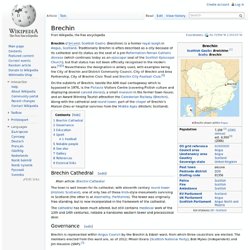
Traditionally Brechin is often described as a city because of its cathedral and its status as the seat of a pre- Reformation Roman Catholic diocese (which continues today as an episcopal seat of the Scottish Episcopal Church ), but that status has not been officially recognised in the modern era. [ 4 ] [ 5 ] Nevertheless the designation is widely used, with examples being the City of Brechin and District Community Council, City of Brechin and Area Partnership, City of Brechin Civic Trust and Brechin City Football Club . [ 6 ] On the outskirts of Brechin, beside the A90 dual carriageway which is bypassed in 1976, is the Pictavia Visitors Centre (covering Pictish culture and displaying several carved stones ), a small museum in the former town house, and an Award Winning Tourist attraction the Caledonian Railway (Brechin) .
Brechin - The Ancient City : Home Page. BRECHINThe Ancient City Location/Maps Information/Statistics History The Storyteller Around and About Brechin & District Brechiners 'n' Ither Fowk Photo-Gallery E-Mail Addresses News/Events Links The Authors Some guid auld Scottish music Flower of Scotland The Flowers Of The Forest The Banks of Loch Lomond Bonnie Dundee Scots Wha' Hae Wi' Wallace Bled Scotland The Brave Dark Lochnagar The Haughs O'Cromdale updated Thursday 04 December 2008 Site established on 25 October 1997 Mail and comments to ericATcaledonius.co.uk.

Brechin Feature Page on Undiscovered Scotland. Brechin is usually only glimpsed in passing by travellers on the main A90 from Dundee to Aberdeen.

And many will know little more about the town than that it has a football club, Brechin City, whose name appears in Grandstand's classified results list every Saturday afternoon. Brechin is a town with a considerable history: even its football club has been around since 1906. In 970 it was described as a "city". This may have been as much in awe at its great circular tower as for any other reason. This tower still stands, now seeming oddly ill at ease off to one side of Brechin Cathedral. Brechin has seen both boom and bust, several times over, during the intervening centuries. Brechin - Towns & Villages in Brechin. Places of Interest in Brechin - FULL LISTING. Brechin Community Website - - Smart Community. Welcome to The Friends of Brechin Town House Museum Website - Home. Brechin Cathedral. Brechin Cathedral dates from the 13th century.
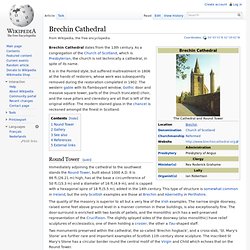
As a congregation of the Church of Scotland, which is Presbyterian, the church is not technically a cathedral, in spite of its name. It is in the Pointed style, but suffered maltreatment in 1806 at the hands of restorers, whose work was subsequently removed during the restoration completed in 1902. The western gable with its flamboyant window, Gothic door and massive square tower, parts of the (much truncated) choir, and the nave pillars and clerestory are all that is left of the original edifice.
Brechin Cathedral. Caledonian Railway (Brechin) The Caledonian Railway (Brechin) Ltd is a private limited company formed by a group of steam railway enthusiasts, the Brechin Railway Preservation Society, with the object of operating a railway service on the former Caledonian Railway line between Brechin and Montrose, Angus, Scotland.
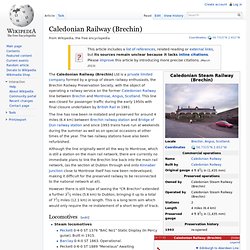
This line was closed for passenger traffic during the early 1950s with final closure undertaken by British Rail in 1981. The line has now been re-instated and preserved for around 4 miles (6.4 km) between Brechin railway station and Bridge of Dun railway station and since 1993 trains have run at weekends during the summer as well as on special occasions at other times of the year. The two railway stations have also been refurbished. However there is still hope of seeing the "CR Brechin" extended a further 3 1⁄2 miles (5.6 km) to Dubton, bringing it up to a total of 7 1⁄2 miles (12.1 km) in length. Caledonian Railway. Robert Watson-Watt. Sir Robert Alexander Watson-Watt, KCB, FRS, FRAeS (13 April 1892 – 5 December 1973) was a pioneer and significant contributor to the development of radar.
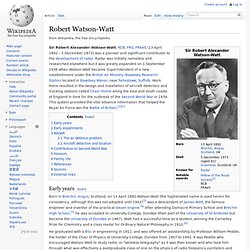
Radar was initially nameless and researched elsewhere but it was greatly expanded on 1 September 1936 when Watson-Watt became Superintendent of a new establishment under the British Air Ministry, Bawdsey Research Station located in Bawdsey Manor, near Felixstowe, Suffolk. Robert Watson-Watt & Radar. Battle of Brechin. The Battle of Brechin was fought on 18 May 1452 during the reign of James II of Scotland, about two and a half miles north north east of Brechin.[1] By some interpretations, it was part of an on-off civil war during his reign between the king and an alliance of powerful noble families led by the Black Douglases, which as the king won was significant in the development of a relatively strong centralised monarchy in Scotland during the Late Middle Ages.[1] A royalist army formed by the Clan Gordon and Clan Ogilvy, led by Alexander Gordon, 1st Earl of Huntly, defeated the rebel Alexander Lindsay, 4th Earl of Crawford, a leading ally of the Black Douglases.[2] Shortly after Crawford submitted to the king, leaving the Black Douglases more isolated, to be defeated at the Battle of Arkinholm in 1455.[1] However by other interpretations it was a localised conflict in the north-east of Scotland, of only limited relevance to wider conflicts in Scotland as a whole.[1] References[edit]
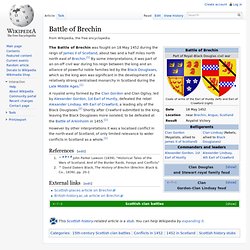
Photographs of Brechin. Brechin Advertiser. ‘It’s pretty repulsive’ — invasion of caterpillars making Brechin woman’s skin crawl - Angus. Brechin City Football Club. Untitled. Brechin Bridge Club. Brechin All Records - Scottish Traditional Folk Music.